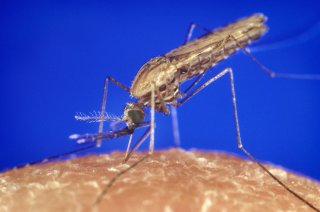
category_news
How flying mosquitoes escape a swatting hand
We all know how difficult it is to swat a mosquito flying at night in your bedroom, but up to now we did not know why. Scientists from Wageningen University have demonstrated that mosquitos achieve this by surfing the airflow bow wave generated by your swatting hand.
The researchers filmed and analysed almost 500 escape manoeuvres of mosquitoes to determine the aerodynamic forces generated by both the mosquito and the airflow. Their findings were recently published in an article in the scientific journal Current Biology.
Two-fold increase collision rate
According to researcher Antoine Cribellier, a combination of keen senses and quick reflexes may help mosquitoes to avoid a life end by riding the air wave produced by a swatter. First, he showed that using a perforated swatter, compared to an unperforated exemplar, to attack free-flying malaria mosquitos led to a two-fold increase collision rate. Which confirms a very old intuition that it is much easier to swat a mosquito with a perforated fly swatter than with your bare hand.
In an earlier study – also published in Current Biology - the research team already showed that mosquitoes are constantly flying unpredictably to increase their chances of evasion. They even discovered that mosquitoes modulate how much unpredictable they are in function of the light conditions. “But in the newest study, our team focused on the details of the escape manoeuvres mosquitoes exhibit when attacked, sometimes in pitch darkness,” explains Cribellier.
High-tech tools: high-speed videography and artificial intelligence
Based on the position and speed of the mosquitoes, a mechanical swatter was automatically activated to simulate the human hand. To understand how mosquitos are using the airflow generated by an attack, the researchers used three high-speed cameras recording 12,500 images per second.
Such high framerate is necessary to be able to describe in detail the movements of mosquito wings, which beat around 500 times per second. The video footage was analysed with AI image recognition software. “By combining these measurements with numerical simulations of the airflow, it was possible to estimate the aerodynamic forces generated by the airflow and the mosquitoes themselves and leading to their successful escape manoeuvres,” Cribellier said.
Mosquitos actively surf on the swatter-induced bow wave
Finally, the researchers were able to uncover how mosquitoes escape from being swatted. They found that mosquitoes use a combination of active and passive mechanisms; first, mosquitoes can detect the attack and actively make a turn away from the danger. Next, the escaping mosquitoes are being pushed away by the airflow induced by the swatter, thus passively moving with the air bow-wave as if surfing on it.
- Unfortunately, your cookie settings do not allow videos to be displayed. - check your settings
The authors also showed that both the active and passive components cannot be neglected. Indeed, depending on whether the swatter was well visible or almost invisible, the passive component accounted for 20% to 40% of the total acceleration mosquito needed to escape. According to the authors, such significant dependence on passive effects when attacked while flying are likely used by millions of insect species of similar or smaller sizes than mosquitoes.
Knowledge as basis for innovations in combating malaria mosquitoes
In future studies, the team would like to discover which of their sensors such as sensible hairs or antennas mosquitoes are using to detect the incoming airflow, and what is the minimum airflow speed that they can detect. Also, they want to investigate how could we use this new knowledge to improve traps that use airflow to capture mosquitoes. Such traps are seen as very promising control tools against mosquitoes to prevent them from spreading diseases like malaria. However, it was found that mosquitoes are often able to avoid the capture zone of these traps where air speeds are the highest. Now that we know how mosquitoes do this, we may be able to adjust traps accordingly.